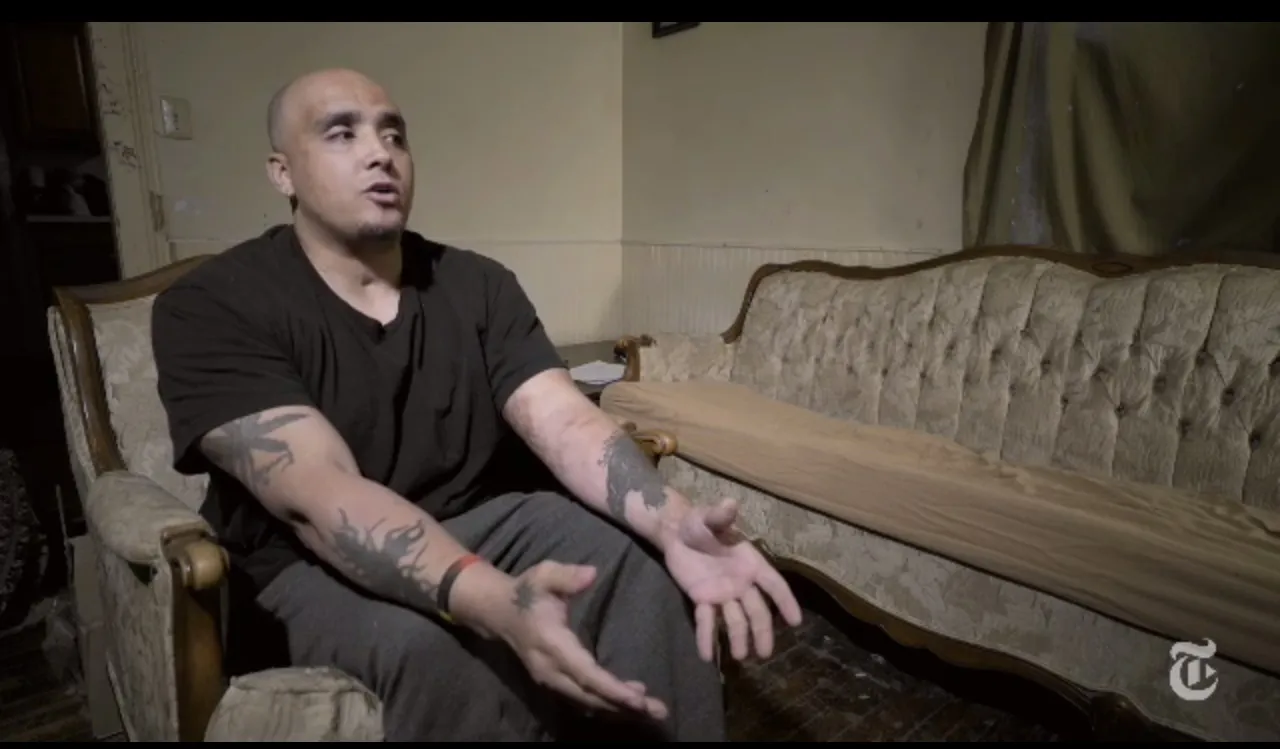It should come as no surprise to even irregular readers of the New York Times that the paper’s editorial view on guns is decidedly hostile.
A headline touting a new TV-episode-length video reporting feature plays this out: “A Backyard Fight Club as an Alternative to Gun Violence.” In watching it, one is transported to the world of reality television. The people are all real, but how real are they?
The video feature tells the story Chris “Scarface” Wilmore in Harrisonburg, VA (population 51,000), a town known to most Virginians as the sleepy Shenandoah town that’s home to James Madison University. Wilmore is a former criminal who did time, and now lives with his family in a house that strangely resembles Tyler Durden’s house / bomb factory in the movie Fight Club. After his friend was murdered on Christmas Eve two years ago, Wilmore decided to start a fight club for people to solve their beefs in “the yard.” Rather than, that is, murdering them.

Chris Wilmore in his home.
Anyone who has been there can tell you that Harrisonburg is not your idyllic college town (like Miami University’s Oxford, Ohio) — it’s an old, historic town with good parts, bad parts, and industry. And as Wilmore tells it, on his side of the tracks, there are a lot of beefs.
What’s odd about Wilmore is that, rather than be the friend who tries to tell two friends to bury the hatchet in some way, shape, or form, he has become a sort of self-appointed sheriff, seeking out discontent in his community and getting people to fight it out; they hug it out later. The no-weapons fight comes with referees, security, rules, and (naturally) a camera crew, though guests aren’t typically allowed to film. At one point, Wilmore asks himself a question I am sure he gets a lot: Doesn’t this potentially create more violence than it otherwise would?
He doesn’t really answer his own question other than to say people have been fighting since the time of Jesus. But in interviews with those who chose to solve their problems with boxing gloves instead of bullets, they seem to feel good about blowing off steam. Though, one loser admits, apropos of nothing, “I’ll be back.”
Nevertheless, fatal shootings are not an epidemic in Harrisonburg, there was one fatal shooting in 2015, and it was at the hands of a police officer. (In Alexandria, where I live, there were four. Only one of which involved the police.) But Wilmore is an evangelist of sorts, Billy Graham with street cred and a rap sheet. His ministry, he hopes, might prevent two murders a year, and he feels that is worth it.
One senses there is an aspect of prison yard justice here: Crowds (including mothers) show up and cheer, and the local cops drive by to keep an eye on things. (They also have started installing cameras on poles in this part of town, the film shows, just as they do in rough areas of Washington, D.C.) Wilmore is skeptical of the police, since he thinks they’re just out to catch people with guns and send them to prison, but says cops have approached him and thanked him for his efforts. Fighting it out, he feels, is a better way to solve things.
Except when he doesn’t.
The end of the storyline revolves around two guys on probation who have a beef over an unpaid debt. Jerone Crawford claims that Theodore Whitelow owes him $1,000. Ted isn’t paying, and he’s talking smack about Jerone. In other words, every reality TV show you’ve ever seen. But filmed exquisitely by the New York Times. (“Hi, I’m from the New York Times and we’re filming a short feature on your local fight club. Do you mind if we mic you up and film you for a weekend while you debate whether to fight some guy in Chris Wilmore’s backyard?”)
There is an aspect of cockfighting or even dog fighting here that is sort of concerning, but unlike the dogs or birds, these people are fighting willingly… even if they’ve been a bit coaxed.
The video begins to come to a close when two guys fighting over a girl is ended. Did it really end their beef? Who knows. But the big fight between Jerone and Theodore is shaping up, and then we’re told that Theodore has been in the fight club before. And got his butt whooped, which is shown, in a fight montage.
Wilmore takes the both of them, with his muscle, to the train tracks to sort it out. He asks if he paid Jerone the debt Theodore allegedly owes him, would they continue to talk smack? There’s a bit of a delay, but apparently now it is OK between them. No fight.
While I doubt the Times is trying to use the video feature to suggest we all start up our own fight clubs, there is a plus side to the Times’ entrance into reality television: No commercials.

